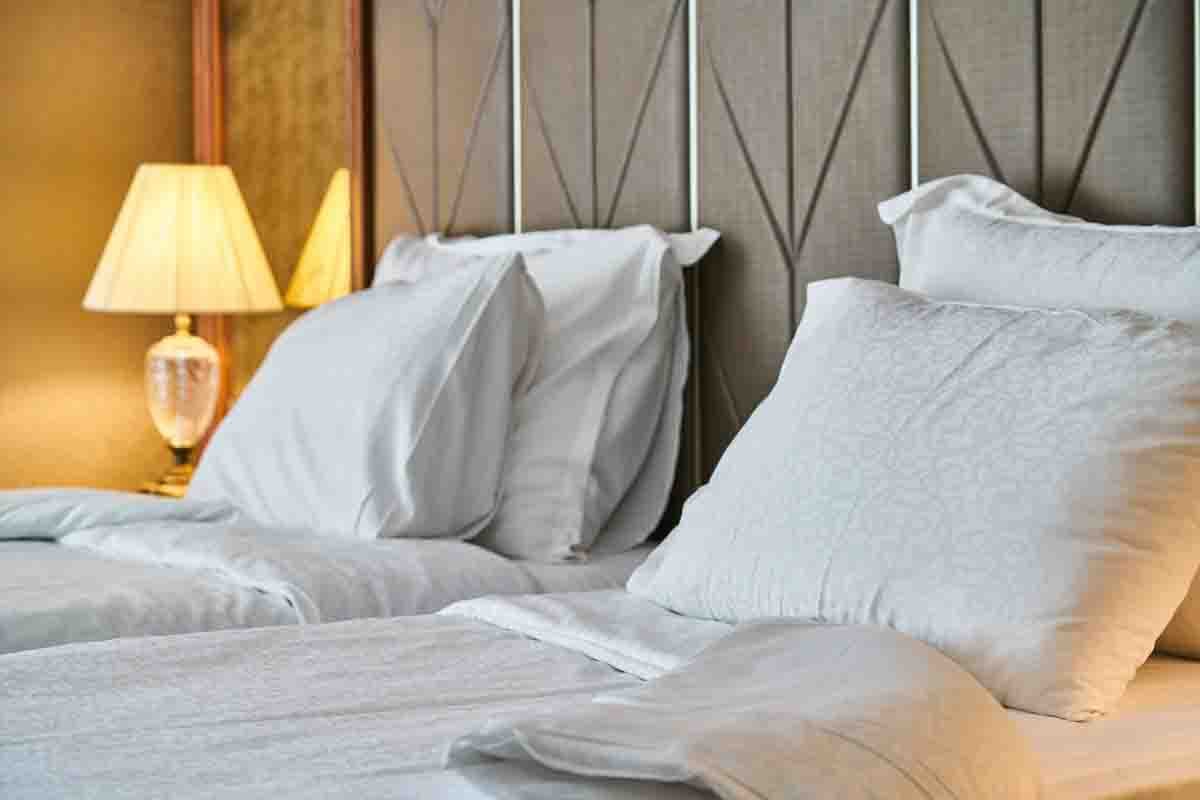
When the sun goes down, experts have noticed that your circadian clock readies your body for bed around two hours before you go to sleep. The more scientific name of circadian rhythm is actually the suprachiasmatic nucleus (SCN). This is a cluster of cells in your brain, directly connected to your retina that wakes you up or makes you drowsy depending on the amount of light in the room. That is also why you may have a difficult time falling asleep when the lights are left on at night.
Working with your SCNs, your pineal gland releases melatonin that will relax your body and gradually make you feel tired. This phenomenon will slow down your metabolism, which in turn, causes your body temperature to decrease. All in all, this chain reaction will make you feel sleepy.
Going to bed, this temperature remains consistent, gradually rising when our circadian rhythm wakes us up for the day. When you go through your day, you may go to different places, eat different food, and feel different emotions. This causes your body temperature to rise and fall. As your body calms down by the end of your day, the same cycle repeats.
Ideal Room Temperature When You Sleep

While the recommended room temperature should be around 16-18 degrees Celsius or 60.8-64.4 degrees Fahrenheit, the ideal is still based on the season, the area of your home, your usual activities, and your temperature preference. If you are still unsure, however, those numbers are a great place to start.
In the wintertime, the temperature should be higher—especially when you have an infant or an elderly person living in your home. During the summertime, the house should be cooler. As warm air travels up, keep the thermostat low in your rooms that sit on higher floors. Since a basement tends to be the coolest part of the house, keep the temperature high there.
Dropping the temperature once everyone heads off for bed is key to comfy sleep. A warm room will keep you from dozing off completely because it signals your brain to be more alert and awake, leading to headaches in the morning. A chilly room can cause cramps and a stuffy nose—at the worst, you can develop sleep apnea from the cold. You will need to find the middle ground.
If you wake up in the middle of the night drenched in sweat and feel disgruntled, you are part of the third of the population who wake up several times during the week—lower your thermostat down to 18 degrees Celsius or 64.4 degrees Fahrenheit. If you want a colder room but have a baby or a young child in the room with you, do not go lower than 17.78 degrees Celsius or 64 degrees Fahrenheit. We also recommend keeping the thermostat at 20 degrees Celsius or 68 degrees Fahrenheit when you are with an elderly person or someone recovering from illness as they are more sensitive to low temperatures. When you are with someone with respiratory problems, keep it at 15.5 Celsius or 60 degrees Fahrenheit.
Ideal Room Temperature for Different Age Groups
Of course, these ideal temperatures differ for different sexes and age groups. Because of this, the bedroom’s temperature should be adjusted accordingly. Here are the ideal temperatures for different age groups:
- For Children
Newborn babies to infants, as they are still developing their most important organs, are still unable to regulate their temperatures in the same way that adults can. That is why their bodies are prone to overheating during the summer and getting a cold in the winter. In other cases that the room is too cold, some infants suffer from Sudden Infant Death Syndrome (SIDS).
Experts recommend keeping the room temperature between 60 degrees Fahrenheit (16 Celsius) to 68 degrees Fahrenheit (20 Celsius). Since their bodies may be more sensitive to ambient temperature changes, it is still better to keep their room one or two degrees warmer. Because their bodies are developing, it’s beneficial to keep the temperature stable. As they grow older, the temperature may increase between 64 degrees Fahrenheit (18 Celsius) to 71 degrees Fahrenheit (22 Celsius).
Make sure to check on your child’s temperature by touching their stomach or their nape. Instead of using heavy blankets or multiple layers, we recommend using the appropriate sleepwear. By the time they turn 11 weeks old, they start to reach a minimum core body temperature of 97.5 degrees Fahrenheit (36.4 Celsius).
- For Adults
In different studies over the years, it has been found that men and women have different preferences for room temperature. This is where the “thermostat wars” term originated. Typically, men favor cooler temperatures than women. In a German study, 500 men and women were asked to take tests in varying temperatures, anywhere from 61 degrees Fahrenheit (16 Celsius) to 90 degrees Fahrenheit (32 Celsius).
The study shows that women’s problem-solving skills improved for every time the test proctors increased the temperature. The conclusion: women are more comfortable and effective in warmer temperatures (68 to 75 degrees Fahrenheit or 20 to 24 Celsius).
For pregnant women who may feel hotter during pregnancy, they need to stay cool and hydrated. Because of this, the temperature needs to be lowered.
- For Elderly
In a study entitled Age and Aging, experts reveal that leaving the elderly in a cold room for 45 minutes is already detrimental to their health. During that time, their muscle strength and overall physical performance is necessary for independent living. With their movement speed and strength hampered, their safety is threatened, increasing the risk of a fall, kidney problems, liver failure and heart attack.
It is also scientifically shown that the elderly have a more difficult time maintaining their body heat. Because of that, their ambient room temperature differs greatly from younger adults and children. On average, a senior’s room temperature should be at least 65 degrees Fahrenheit (18 Celsius) up to 78 degrees Fahrenheit (25 Celsius).
Now that you’re at a more comfortable state than you were before, it’s also important to understand how a stable temperature affects the quality of your sleep.
How Room Temperature Affects Deep Sleep

Sleeping prepares your body for the next day. It helps your brain process necessary information and maintains your physical health. As it is, not only should you let yourself rest but also make sure that you feel comfortable. Contrary to popular belief, it’s not caffeine that gets you through the following day but a good night’s sleep.
In order for your body to properly recuperate and process necessary information for the following day, it needs to go through different phases. There are two different kinds of sleep: non-rapid eye movement (NREM) sleep and rapid eye movement (REM) sleep. The first three phases are considered NREM.
- N1
When your eyes feel heavy and you drift off to sleep, your brain produces alpha and theta waves. These put your brain in a state of wakeful rest, allowing it to calm down from processing information from your day. When your brain is at ease, your muscles start to relax. Later on, you might experience muscle spasms or even feel like falling during this stage. This typically takes 5-10 minutes in the sleep cycle for an average person. When your lifestyle begins to change or you begin to age, the length of your sleep cycle can change.
- N2
When this stage begins, your body is preparing for deep sleep. Your eye stops rolling completely, heart rate slows, and body temperature drops. If someone tries to wake you up, it will be harder to rouse you from your sleep. Your mind slows down with specific bursts of activity or sleep spindles—these are brain waves that signal complex activity during sleep. This typically lasts for about 25 minutes.
- N3
During this stage, your body goes into a deep sleep and prepares for REM sleep. Your body is less sensitive to the external environment as your brain waves transition to delta waves or slow waves. This is also when your body starts to repair broken tissues, boosting immunity and cell growth. This stage lasts for about 45-90 minutes for the average person. If you are awakened in this state, you feel disoriented. Because the muscles are still in the process of relaxing, this is when the sleepwalking phenomenon takes place.
- Rapid Eye Movement (REM) sleep
While your brain waves slow down during the NREM stage, the opposite happens during REM sleep. The brain spikes with activity while your heart rate, blood pressure, and eye movement increase. As your brain gives off mixed frequencies, it processes the information you have learned and stores important ones for easy recall. Your skeletal muscles are also paralyzed so that you aren’t moving while you dream. This stage lasts for up to 90 minutes for average people.
A full cycle of sleep will last for about 90 minutes that repeat for up to seven to nine hours. You can learn more about this “rule of the golden 90 minutes” in the Stanford Method for Ultimate Sound Sleep by Professor Seiji Nishino. It is also worth noting that you might feel groggier on some mornings more than others because you woke up on a REM or NREM stage 3 phase.
While REM can help our bodies increase memory retention and physical relaxation, it is not able to regulate your temperature while asleep. Because regulating your temperature (e.g. sweating, forming goosebumps, panting, etc,.) takes a lot of energy, your body cannot do it simultaneously with REM.
However, if you find yourself in a sleeping environment where your room is warmer or colder than your preferred temperature level, your body will sacrifice precious REM time in favour of regulating your temperature. Because of this, you may wake up feeling more exhausted or needing more sleep than you normally do. In a study by Markus Schmidt from the University of Bern, he found that people have hormones in their brain that assess whether we are too warm or cold. Based on this assessment, your body will make the necessary adjustments to meet your body’s needs.
In some cases, your hormones can wake you up to make physical changes to your environment, like adjusting your thermostat, wearing more comfortable clothes, or adding another layer of blanket. Sometimes, your body will release sweat if it is too warm, and experience chills, it is too cold..
Encouraging a Harmonious Sleep With Electric Underblanket
Keeping a room cool is not enough—a humid room only increases your discomfort whether the room is chilly or warm. Make sure that your room is well-ventilated and dry to keep the air circulating and crisp.
Before you get into bed, take a warm shower to help your muscles relax. As the room starts to cool, you may carry in a warm water bottle or plug in your electric underblanket to keep your legs warm. This prevents you from waking up feeling stiff in the morning when your body temperature is low.
4D DWF technology disperses the heat generated by our blankets through uniquely designed holes, allowing them to give you ideal conditions for sufficient and comfortable sleep.
Interested in experiencing warmth and comfort like no other? Buy Wellcare’s electric blankets by clicking on the link below. Find out what sets them apart from conventional electric blankets, and the science that comes with creating the next step to sleeping in comfort.
At Wellcare, we believe that sleep is a basic human right. Our 4D DWF technology makes it so that the heat generated by our blankets disperses through uniquely designed holes, so you can experience the ideal conditions for sufficient and comfortable sleep.
Are you interested in becoming a distributor of Wellcare's 4D DWF products? Click on the link below to learn more about 4D DWF electric blankets and heating pads - what sets them apart from conventional electric blankets, and the science that comes with creating the next step to sleeping in comfort.
Resource: https://academic.oup.com/ageing/article/43/4/571/2812220


.png?width=512&name=united-kingdom%20(1).png)


